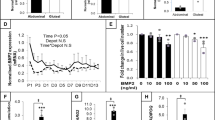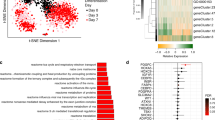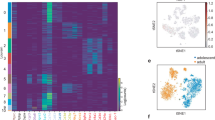Abstract
Objective:
Insulin resistance and type 2 diabetes mellitus (T2DM) are associated with increased adipocyte size, altered secretory pattern and decreased differentiation of preadipocytes. In this study, we identified the underlying molecular processes in preadipocytes of T2DM patients, a characteristic for the development of T2DM.
Design and Participants:
Preadipocyte cell cultures were prepared from subcutaneous fat biopsies of seven T2DM patients (age 53±12 years; body mass index (BMI) 34±5 kg m–2) and nine control subjects (age 51±12 years; BMI 30±3 kg m–2). Microarray analysis was used to identify altered processes between the T2DM and control preadipocytes.
Results:
Gene expression profiling showed changed expression of transcription regulators involved in adipogenesis and in extracellular matrix remodeling, actin cytoskeleton and integrin signaling genes, which indicated decreased capacity to differentiate. Additionally, genes involved in insulin signaling and lipid metabolism were downregulated, and inflammation/apoptosis was upregulated in T2DM preadipocytes.
Conclusion:
Decreased expression of genes involved in differentiation can provide a molecular basis for the reduced adipogenesis of preadipocytes of T2DM subjects, leading to reduced formation of adipocytes in subcutaneous fat depots, and ultimately leading to ectopic fat storage.
This is a preview of subscription content, access via your institution
Access options
Subscribe to this journal
Receive 12 print issues and online access
$259.00 per year
only $21.58 per issue
Buy this article
- Purchase on Springer Link
- Instant access to full article PDF
Prices may be subject to local taxes which are calculated during checkout



Similar content being viewed by others
Accession codes
References
Sell H, Eckel J, Dietze-Schroeder D . Pathways leading to muscle insulin resistance–the muscle–fat connection. Arch Physiol Biochem 2006; 112: 105–113.
King H, Aubert RE, Herman WH . Global burden of diabetes, 1995–2025: prevalence, numerical estimates, and projections. Diabetes Care 1998; 21: 1414–1431.
Bloomgarden ZT . American Diabetes Association Annual Meeting, 1999: diabetes and obesity. Diabetes Care 2000; 23: 118–124.
Puska P, Nishida C, Porter D . Obesity and Overweight. World Health Organization, 2003; http://www.who.int/hpr/NPH/docs/gs_obesity.pdf.
Jazet IM, Pijl H, Meinders AE . Adipose tissue as an endocrine organ: impact on insulin resistance. Neth J Med 2003; 61: 194–212.
Heilbronn L, Smith SR, Ravussin E . Failure of fat cell proliferation, mitochondrial function and fat oxidation results in ectopic fat storage, insulin resistance and type II diabetes mellitus. Int J Obes Relat Metab Disord 2004; 28 (Suppl 4): S12–S21.
Goralski KB, Sinal CJ . Type 2 diabetes and cardiovascular disease: getting to the fat of the matter. Can J Physiol Pharmacol 2007; 85: 113–132.
Kahn BB, Flier JS . Obesity and insulin resistance. J Clin Invest 2000; 106: 473–481.
Hajer GR, van Haeften TW, Visseren FL . Adipose tissue dysfunction in obesity, diabetes, and vascular diseases. Eur Heart J 2008; 29: 2959–2971.
Cinti S . The adipose organ. Prostaglandins Leukot Essent Fatty Acids 2005; 73: 9–15.
Lundgren M, Svensson M, Lindmark S, Renstrom F, Ruge T, Eriksson JW . Fat cell enlargement is an independent marker of insulin resistance and ‘hyperleptinaemia’. Diabetologia 2007; 50: 625–633.
Yang X, Jansson PA, Nagaev I, Jack MM, Carvalho E, Sunnerhagen KS et al. Evidence of impaired adipogenesis in insulin resistance. Biochem Biophys Res Commun 2004; 317: 1045–1051.
Nair S, Lee YH, Rousseau E, Cam M, Tataranni PA, Baier LJ et al. Increased expression of inflammation-related genes in cultured preadipocytes/stromal vascular cells from obese compared with non-obese Pima Indians. Diabetologia 2005; 48: 1784–1788.
Hammarstedt A, Isakson P, Gustafson B, Smith U . Wnt-signaling is maintained and adipogenesis inhibited by TNFalpha but not MCP-1 and resistin. Biochem Biophys Res Commun 2007; 357: 700–706.
Dahlman I, Forsgren M, Sjogren A, Nordstrom EA, Kaaman M, Naslund E et al. Downregulation of electron transport chain genes in visceral adipose tissue in type 2 diabetes independent of obesity and possibly involving tumor necrosis factor-alpha. Diabetes 2006; 55: 1792–1799.
Lee YH, Nair S, Rousseau E, Allison DB, Page GP, Tataranni PA et al. Microarray profiling of isolated abdominal subcutaneous adipocytes from obese vs non-obese Pima Indians: increased expression of inflammation-related genes. Diabetologia 2005; 48: 1776–1783.
Eurlings PM, Van Der Kallen CJ, Geurts JM, Kouwenberg P, Boeckx WD, De Bruin TW . Identification of differentially expressed genes in subcutaneous adipose tissue from subjects with familial combined hyperlipidemia. J Lipid Res 2002; 43: 930–935.
Troost FJ, van Baarlen P, Lindsey P, Kodde A, de Vos WM, Kleerebezem M et al. Identification of the transcriptional response of human intestinal mucosa to Lactobacillus plantarum WCFS1 in vivo. BMC Genomics 2008; 9: 374.
Akaike H . Information theory and an extension of the maximum likelihood principle. In: Petrov BN, Csàki F (eds). Second International Symposium on Inference Theory. Akadémiai Kiadó: Budapest, 1973. pp 267–281.
Salomonis N, Hanspers K, Zambon AC, Vranizan K, Lawlor SC, Dahlquist KD et al. GenMAPP 2: new features and resources for pathway analysis. BMC Bioinformatics 2007; 8: 217.
Doniger SW, Salomonis N, Dahlquist KD, Vranizan K, Lawlor SC, Conklin BR . MAPPFinder: using Gene Ontology and GenMAPP to create a global gene-expression profile from microarray data. Genome Biol 2003; 4: R7.
Ashburner M, Ball CA, Blake JA, Botstein D, Butler H, Cherry JM et al. Gene ontology: tool for the unification of biology. The Gene Ontology Consortium. Nat Genet 2000; 25: 25–29.
Ihaka R, entleman R . ‘R: a language for data analysis and graphics’. J Comput Graph Stat 1996; 5: 299–314.
Lindsey J . Models for Repeated Measurements, 2nd edn. Oxford University Press: Oxford, 1999.
van Vlies N, Ruiter JP, Doolaard M, Wanders RJ, Vaz FM . An improved enzyme assay for carnitine palmitoyl transferase I in fibroblasts using tandem mass spectrometry. Mol Genet Metab 2007; 90: 24–29.
Wabitsch M, Brenner RE, Melzner I, Braun M, Moller P, Heinze E et al. Characterization of a human preadipocyte cell strain with high capacity for adipose differentiation. Int J Obes Relat Metab Disord 2001; 25: 8–15.
Morey JS, Ryan JC, Van Dolah FM . Microarray validation: factors influencing correlation between oligonucleotide microarrays and real-time PCR. Biol Proced Online 2006; 8: 175–193.
Meex SJ, van der Kallen CJ, van Greevenbroek MM, Eurlings PM, El Hasnaoui M, Evelo CT et al. Up-regulation of CD36/FAT in preadipocytes in familial combined hyperlipidemia. FASEB J 2005; 19: 2063–2065.
Li D, Yea S, Li S, Chen Z, Narla G, Banck M et al. Kruppel-like factor-6 promotes preadipocyte differentiation through histone deacetylase 3-dependent repression of DLK1. J Biol Chem 2005; 280: 26941–26952.
Bentov I, Narla G, Schayek H, Akita K, Plymate SR, LeRoith D et al. Insulin-like growth factor-i regulates Kruppel-like factor-6 gene expression in a p53-dependent manner. Endocrinology 2008; 149: 1890–1897.
Hackl H, Burkard TR, Sturn A, Rubio R, Schleiffer A, Tian S et al. Molecular processes during fat cell development revealed by gene expression profiling and functional annotation. Genome Biol 2005; 6: R108.
Oishi Y, Manabe I, Tobe K, Tsushima K, Shindo T, Fujiu K et al. Kruppel-like transcription factor KLF5 is a key regulator of adipocyte differentiation. Cell Metab 2005; 1: 27–39.
Le Lay S, Lefrere I, Trautwein C, Dugail I, Krief S . Insulin and sterol-regulatory element-binding protein-1c (SREBP-1C) regulation of gene expression in 3T3-L1 adipocytes. Identification of CCAAT/enhancer-binding protein beta as an SREBP-1C target. J Biol Chem 2002; 277: 35625–35634.
Ramji DP, Foka P . CCAAT/enhancer-binding proteins: structure, function and regulation. Biochem J 2002; 365: 561–575.
Miyaoka Y, Tanaka M, Naiki T, Miyajima A . Oncostatin M inhibits adipogenesis through the RAS/ERK and STAT5 signaling pathways. J Biol Chem 2006; 281: 37913–37920.
Eguchi J, Yan QW, Schones DE, Kamal M, Hsu CH, Zhang MQ et al. Interferon regulatory factors are transcriptional regulators of adipogenesis. Cell Metab 2008; 7: 86–94.
Gregoire FM . Adipocyte differentiation: from fibroblast to endocrine cell. Exp Biol Med (Maywood) 2001; 226: 997–1002.
Dubois SG, Heilbronn LK, Smith SR, Albu JB, Kelley DE, Ravussin E . Decreased expression of adipogenic genes in obese subjects with type 2 diabetes. Obesity (Silver Spring) 2006; 14: 1543–1552.
Wang MY, Grayburn P, Chen S, Ravazzola M, Orci L, Unger RH . Adipogenic capacity and the susceptibility to type 2 diabetes and metabolic syndrome. Proc Natl Acad Sci USA 2008; 105: 6139–6144.
Tseng YH, Butte AJ, Kokkotou E, Yechoor VK, Taniguchi CM, Kriauciunas KM et al. Prediction of preadipocyte differentiation by gene expression reveals role of insulin receptor substrates and necdin. Nat Cell Biol 2005; 7: 601–611.
Wang P, Keijer J, Bunschoten A, Bouwman F, Renes J, Mariman E . Insulin modulates the secretion of proteins from mature 3T3-L1 adipocytes: a role for transcriptional regulation of processing. Diabetologia 2006; 49: 2453–2462.
Vu TH, Werb Z . Matrix metalloproteinases: effectors of development and normal physiology. Genes Dev 2000; 14: 2123–2133.
Kawaguchi N, Sundberg C, Kveiborg M, Moghadaszadeh B, Asmar M, Dietrich N et al. ADAM12 induces actin cytoskeleton and extracellular matrix reorganization during early adipocyte differentiation by regulating beta1 integrin function. J Cell Sci 2003; 116: 3893–3904.
Janke J, Engeli S, Gorzelniak K, Luft FC, Sharma AM . Mature adipocytes inhibit in vitro differentiation of human preadipocytes via angiotensin type 1 receptors. Diabetes 2002; 51: 1699–1707.
Brown NF, Hill JK, Esser V, Kirkland JL, Corkey BE, Foster DW et al. Mouse white adipocytes and 3T3-L1 cells display an anomalous pattern of carnitine palmitoyltransferase (CPT) I isoform expression during differentiation. Inter-tissue and inter-species expression of CPT I and CPT II enzymes. Biochem J 1997; 327 (Part 1): 225–231.
Jocken JW, Langin D, Smit E, Saris WH, Valle C, Hul GB et al. Adipose triglyceride lipase and hormone-sensitive lipase protein expression is decreased in the obese insulin-resistant state. J Clin Endocrinol Metab 2007; 92: 2292–2299.
Acknowledgements
We thank Martin Wabitsch for kindly providing the SGBS cells, Glaxo Smith Kline for kindly providing Rosiglitazone and the Microarray Facility Utrecht for providing the oligonucleotide microarrays. The research presented was funded by the Dutch Diabetes Foundation (DFN 2004.00.040).
Author information
Authors and Affiliations
Corresponding author
Ethics declarations
Competing interests
The authors declare no conflict of interest.
Additional information
Supplementary Information accompanies the paper on International Journal of Obesity website
Rights and permissions
About this article
Cite this article
van Tienen, F., van der Kallen, C., Lindsey, P. et al. Preadipocytes of type 2 diabetes subjects display an intrinsic gene expression profile of decreased differentiation capacity. Int J Obes 35, 1154–1164 (2011). https://doi.org/10.1038/ijo.2010.275
Received:
Revised:
Accepted:
Published:
Issue Date:
DOI: https://doi.org/10.1038/ijo.2010.275
Keywords
This article is cited by
-
Activation of cell adhesion and migration is an early event of platelet-rich plasma (PRP)-dependent stimulation of human adipose-derived stem/stromal cells
Human Cell (2023)
-
Stomatin modulates adipogenesis through the ERK pathway and regulates fatty acid uptake and lipid droplet growth
Nature Communications (2022)
-
Preadipocytes from obese humans with type 2 diabetes are epigenetically reprogrammed at genes controlling adipose tissue function
International Journal of Obesity (2019)
-
Epigenome-wide DNA methylation profiling of periprostatic adipose tissue in prostate cancer patients with excess adiposity—a pilot study
Clinical Epigenetics (2018)
-
Platelet-rich plasma enhances the proliferation of human adipose stem cells through multiple signaling pathways
Stem Cell Research & Therapy (2018)



